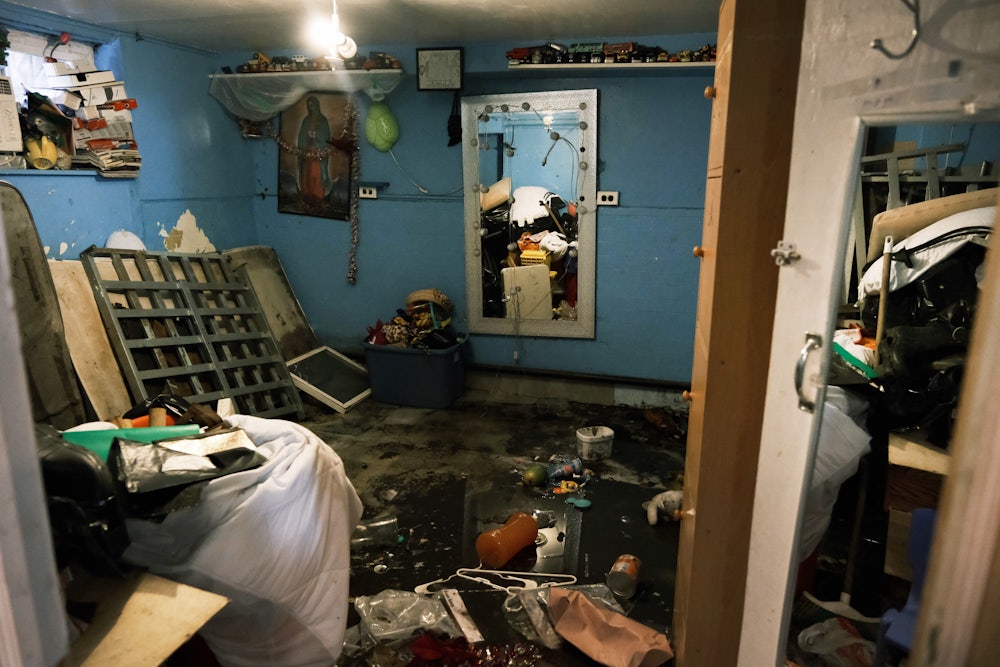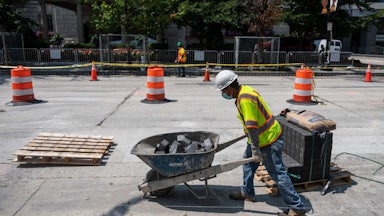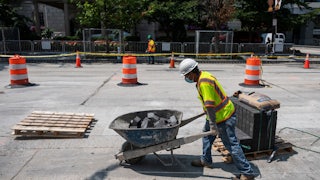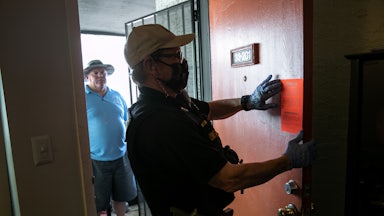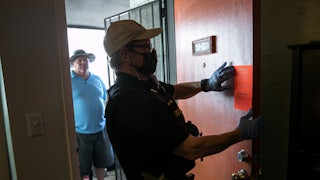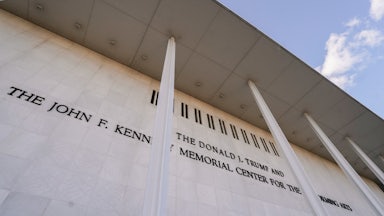The night of September 1, when Hurricane Ida arrived in New York City, Wanda Mathis heard a noise in the bathroom. She went in to check it out and saw water “gushing from the bathroom light. It was just sliding all over the walls, falling heavy, like we were outside,” she said. Water leaked down into her bedroom, pouring out of her closet. Mathis and her son have lived in their building in Crown Heights, Brooklyn, for more than 20 years, and her elderly mother was staying with them when the storm hit. “I was up all night long, mopping, pouring out water,” Mathis said. Another long-time tenant in the neighborhood, Sharon Wilson, described something similar in her building: The noise she thought was rain outside her windows was in fact the sound of it coming down inside.
Ida immobilized the subway system, left ceilings bulging with dirty water, and flooded countless basements. This past summer was one of the wettest in New York’s history, and Ida was one of many weather events that transformed streets into rivers and park steps into waterfalls, and tested the city’s aged housing stock.
Mathis and Wilson had reason to worry before this summer of storms. They had long complained of deferred maintenance and pest problems in their building; in fact, Wilson had documented shoddy repairs to the roof in a court petition against her landlord, Lewis Barbanel, back in February. Barbanel is on the New York City public advocate’s worst landlords list—as of October 5, the city had logged 156 open violations for Mathis’s and Wilson’s buildings on Eastern Parkway in Brooklyn. Beyond water leaks and mold, the city has found mice and roach infestations, a lack of heat in some units, and other dangerous structural conditions. In July, a tenant of one of Barbanel’s buildings had her ceiling collapse on top of her. (In an email, a representative for Barbanel’s management company, Christopher Sciocchetti, called the “worst landlords” list “a purely political act,” based on outdated data, and said that there was “no history of deferred maintenance.” All open violations had been addressed, he said, but the buildings needed to be inspected before they could be removed from the record.)
Sciocchetti claimed the company made timely repairs before and after this summer’s floods, but Mathis said that while Barbanel did send a crew to her place, they initially plastered over mold rather than fully removing it. They have yet to return to finish patching up.
Talk of disaster recovery and climate resilience has largely focused on homeowners—on the asset value of their properties, their ability to retrofit their homes in preparation for extreme weather, or their decision to relocate following a disaster. Tenants are left out of this conversation, though they are even more vulnerable because they don’t have the power to make decisions about buildings they live in. Enforcement mechanisms to get landlords to make repairs can be slow or lacking. This problem is not unique to New York City or to storm damage—in a place with life-threatening heat like Arizona, tenants struggle to get landlords to keep their air conditioners running, even though the state deems it an essential service that property owners must provide.
I have heard similar complaints as a volunteer for the Metropolitan Council on Housing’s Tenant Hotline, which helps renters in the sticky position of asserting themselves against the person or company that owns their home. (The renters who spoke with me for this piece I met outside of my volunteer work.) New York City has some of the strongest tenant protections in the country, but it’s not easy to navigate complex city bureaucracies, and not all tenants have the time, energy, or skill set to do so.
Anna Thibeault considers herself “pretty lucky.” Her apartment in Brooklyn flooded to the point of dangerous uninhabitability in June, during a particularly heavy rainstorm, but Thibeault has a friend who is a lawyer who helped her draft an appeal letter to her rental insurance company, and the damage was covered. Her job gave her time off to deal with the mess. Still, the experience was extremely stressful and resulted in her relocating to a new neighborhood. Many people, Thibeault noted, wouldn’t have a professional network like hers to call on, or have renter’s insurance in the first place.
New York City tenants can sue their landlords in housing court to obtain repairs, and the city can levy civil penalties against noncompliant building owners. However, the court rarely holds landlords accountable, and the fines the city pursues tend to be low. Armen Merjian, a senior staff attorney at the nonprofit Housing Works, has written about the lack of consequences for lax landlords: Between 2011 and 2016, Merjian found, New York City housing court meted out fewer than 50 contempt rulings against landlords for failing to make repairs. In the same time frame, the court system yielded nearly 118,000 evictions. Even when tenants do prevail, it usually amounts to a slap on the wrist for big landlords. For example, the city took Barbanel to court in 2019 for failing to provide heat and hot water to tenants in Mathis’s building, and it resulted in a civil penalty of just $1,000, an amount unlikely to deter a property owner with such a large portfolio.
Extreme weather is now colliding with these long-term problems for tenants in New York and many other parts of the country. It is a common credo among climate justice advocates that low-income people and people of color face “first and worst” risks relative to whiter and wealthier populations; Black and Hispanic renters already experience substandard housing conditions at a higher rate than white renters in New York City.
“NYC is in a housing crisis,” said Deborah Morris, a lecturer at the Harvard Graduate School of Design who previously worked on climate resiliency with the city’s Housing Preservation and Development agency. “And the quality of the housing is really, really poor. The pressure pushes vulnerable people into vulnerable places. Our buildings are not built to deal with the weather we’re experiencing now.” A small problem in good weather—a leaky seal, a clogged drain—can turn catastrophic in a flood. Morris noted that deferred maintenance or second-rate repairs following a storm might be due to a small landlord’s lack of know-how. In other instances, it can be the result of general negligence or even a tactic used to push tenants out of rent-stabilized apartments.
Forcing landlords to make repairs can be a double-edged sword, because it may result in tenants losing their housing in a market where reasonable, livable options are scarce. This is especially true in the case of the city’s tens of thousands of illegal basement apartments, where at least 11 people drowned during Ida. “I don’t think anyone should live in a basement [apartment],” given the condition they are often in, said Morris, but she understands why housing advocates continue to campaign for their legalization. (Last year, New York Mayor Bill de Blasio slashed the budget for a program helping people convert basements to legitimate rental units.) Affordable housing of any kind is a precious resource. After disasters, tenants who experience major damage are displaced from their homes, and even if they are able to move back in, rents may go up after repairs, as the immigrant rights group Make the Road New York found after Hurricane Sandy in 2012.
Without long-term investment in social housing, there are few solutions to the precarious position of renters facing down climate change. New York City does have an emergency repairs program, which allows the city to make necessary fixes and then charge landlords after the fact; such programs could be expanded. Morris also stressed that the city should put more resources toward building inspections, rather than relying on tenants to report and follow through on problems.
On a national scale, Sarah Saadian, vice president of public policy at the National Low Income Housing Coalition, pointed to the many problems with accessing federal disaster recovery assistance, which is biased toward higher-income homeowners. There is some effort to streamline this process for renters, and another effort at the federal level via a bill introduced by Florida Representative Val Demings, which would institute eviction moratoriums whenever the federal government declares a disaster. While tenant rights mostly exist at the state and local level, Saadian said, “We are seeing more and more members of Congress who are recognizing that there is this enormous power imbalance that exists between renters and landlords that puts renters at risk.” Beyond disaster recovery, she said, Congress could help by passing laws giving tenants the right to counsel, access to legal aid, and just-cause eviction protections.
In the meantime, renters like Mathis have turned to tenant union activism to pressure landlords to take more care. In addition to filing a court action against Mathis’s landlord, the Crown Heights Tenant Union #7 has participated in pickets, rent strikes, and mutual aid. Both Mathis and Wilson know all about the problems faced by their neighbors in their buildings. As Kate Ehrenberg, the hotline coordinator for the Metropolitan Council on Housing, put it, “No one else is going to enforce tenants’ rights besides tenants themselves.” Climate resilience is not simply a matter of physical preparedness but also enforcing the need for basic repairs and crafting policies to support the millions of renters currently at the mercy of their landlords.
